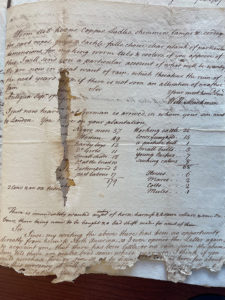A Tale From the Archives: Trying To Write About Eighteenth-Century Equines.
This guest post was written by Dr. Charlotte Carrington-Farmer, whose recent research at the NHS was supported by the New England Regional Fellowship Consortium. Charlotte’s research topic is ‘Equine Labour: Horses and the Making of New England.’
During the summer of 2020, I started my NERFC fellowship at Newport Historical Society (no mean feat in a pandemic.) My fellowship research centred on examining the countless New England vessels that braved the Atlantic Ocean in a quest for profit by delivering horses to the sugar colonies in the eighteenth century. My research examines how New England’s export of equines was part of a wider chain of supply and demand around the Atlantic world. Building upon new works that fully connect New England to the West Indies, my work also ties in with the animal turn in history. To this end, I was ploughing through records at NHS related to Newport merchant William Redwood’s plantation in Antigua. By looking at letters, reports, and inventories I was trying to get an overall sense of the role that horses played on plantation. I was hoping to discover all kinds of equine information, such as the average number of horses on the plantation in any given year, what breed of horses were typical, what jobs they did, where they came from, and how much they cost and so on. I distinctly remember feeling very disappointed when a list of the animals on the plantation in 1753 provided me with barest of details:
Horses … 6
Mares…2
Colts…2
Mules…1

Listing of animals on William Redwood’s plantation in Antigua. Box 35 Folder 6, NHS Collections.
None of the rich minutiae that I so desperately wanted (and needed) for my project. At this point, I had no interest in (or intention of) looking into mules. However, as is often the case, the sources had other plans for me. As I was about to turn the page, I spotted something that caught my eye. At the bottom of the page, which was obviously torn, there was a very unexpected reference to mules, which immediately made me pause. On the scrap of paper, William Mackinen, the plantation manager, was writing back to Redwood in Newport, with an update about the plantation. At first glance, the update was very straightforward and bemoaned the lack of rain and ships – nothing ground-breaking. But, at the end, he wrote an almost throwaway line: “I am told there are mules bred some where near you.” I stopped and paused, Rhode Islanders were breeding mules in 1753! Moreover, a plantation manager in Antigua knew this and wanted in on the action. Up to this point, I had come across a few scatted references to New Englanders breeding mules for export to the sugar colonies from the 1780s, but certainly nothing this early. Filling in the gaps, Mackinen advised Redwood to look into purchasing five or six mules to ship to Antigua. The discovery pushed me to reconceptualise my project. The more I dived into the sources, the more references I found to mule breeding for export. New England’s efforts to breed mules for export will now be at least one chapter in my monograph and they are the sole subject of an upcoming standalone chapter in an edited collection. This is all thanks to the chance finding of a partially torn letter when I was searching for something entirely different.